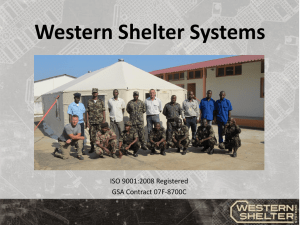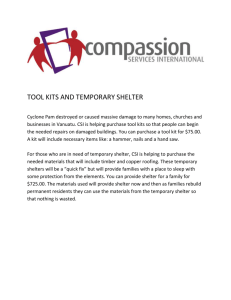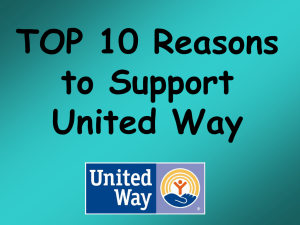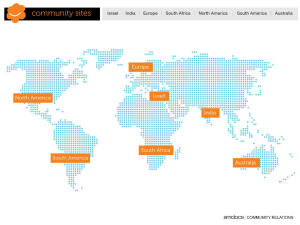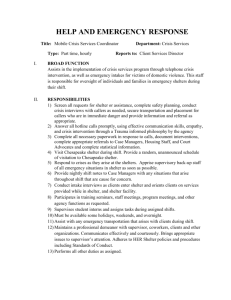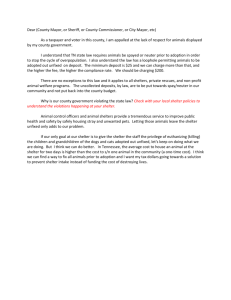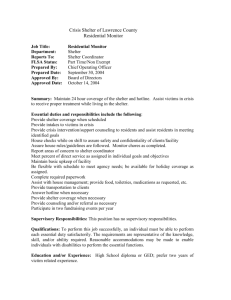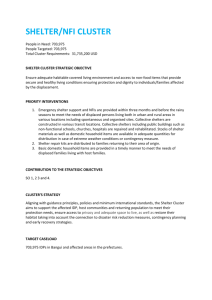SPECIAL NEEDS REG - Baker County Sheriff`s Office
advertisement
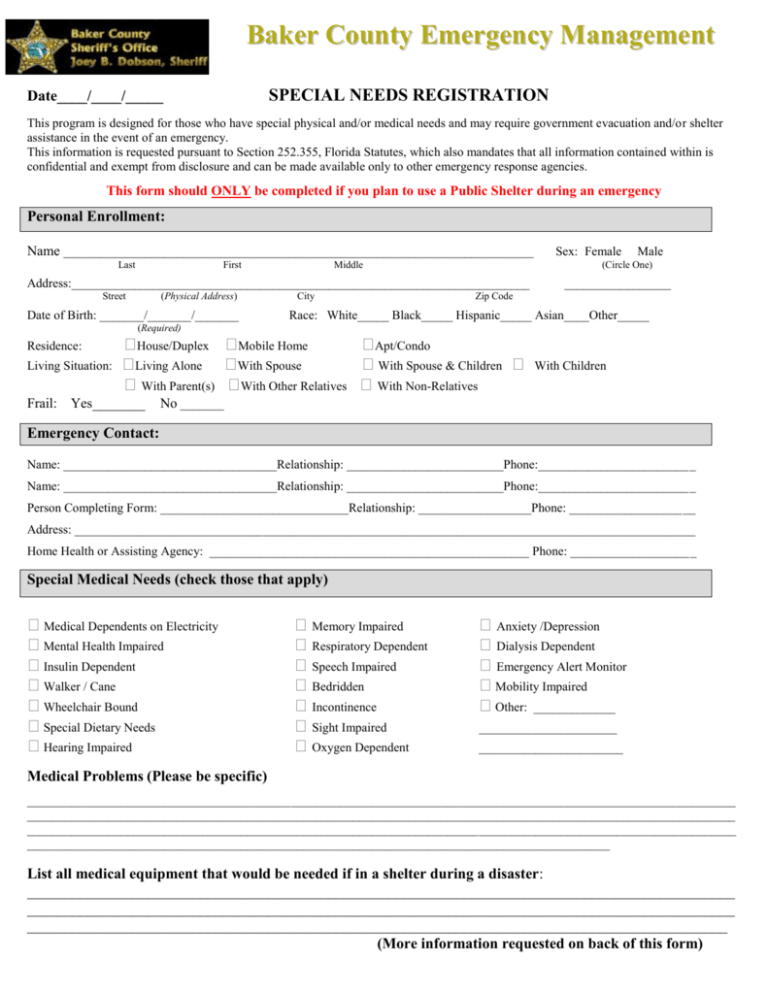
Baker County Emergency Management SPECIAL NEEDS REGISTRATION Date____/____/_____ This program is designed for those who have special physical and/or medical needs and may require government evacuation and/or shelter assistance in the event of an emergency. This information is requested pursuant to Section 252.355, Florida Statutes, which also mandates that all information contained within is confidential and exempt from disclosure and can be made available only to other emergency response agencies. This form should ONLY be completed if you plan to use a Public Shelter during an emergency Personal Enrollment: Name ___________________________________________________________________________ Last First Middle (Physical Address) Date of Birth: _______/_______/_______ City Male (Circle One) Address:_________________________________________________________________________ Street Sex: Female _________________ Zip Code Race: White_____ Black_____ Hispanic_____ Asian____Other_____ (Required) Residence: Living Situation: House/Duplex Mobile Home Apt/Condo Living Alone With Spouse With Spouse & Children With Parent(s) With Other Relatives With Non-Relatives Frail: Yes_______ With Children No _______ Emergency Contact: Name: __________________________________Relationship: _________________________Phone:_________________________ Name: __________________________________Relationship: _________________________Phone:_________________________ Person Completing Form: ______________________________Relationship: __________________Phone: ____________________ Address: ___________________________________________________________________________________________________ Home Health or Assisting Agency: ___________________________________________________ Phone: ____________________ Special Medical Needs (check those that apply) Medical Dependents on Electricity Mental Health Impaired Insulin Dependent Walker / Cane Wheelchair Bound Special Dietary Needs Hearing Impaired Memory Impaired Respiratory Dependent Speech Impaired Bedridden Incontinence Sight Impaired Oxygen Dependent Anxiety /Depression Dialysis Dependent Emergency Alert Monitor Mobility Impaired Other: _____________ ______________________ _______________________ Medical Problems (Please be specific) _________________________________________________________________________________________________________________ _________________________________________________________________________________________________________________ _________________________________________________________________________________________________________________ _____________________________________________________________________________________________ List all medical equipment that would be needed if in a shelter during a disaster: ______________________________________________________________________________________________ ______________________________________________________________________________________________ _____________________________________________________________________________________________ (More information requested on back of this form) Primary Doctor: _________________________________________Telephone (_______) _______________________ Pharmacy Name: ________________________________________ Telephone (_______) _______________________ Health Insurance Company: _______________________________ Telephone (_______) _______________________ Allergies: _________________________________________________________________________________________ Medications: _______________________ ___________________________ ___________________________ _______________________ ___________________________ __________________________ _______________________ ___________________________ __________________________ In the event of a disaster, please check one of the following: Staying at home - - Staying with relatives or friends Public Shelter – Needs can be met in non-medical facility Medical Supervision Shelter—Requires general medical supervision Special Needs Shelter—Requires a special monitoring and assistance Hospital—Requires acute medical care Assistance Required: Transportation to a shelter needed: YES _____ NO _____ Bus Car Wheelchair Van Ambulance (See Notes) Check Needs: PETS: Assistance in a Shelter: YES _______NO _______ Check Needs: Personal Care Feeding Taking Medicine Other (Specify) Cat __________ Dog ____________ Guide Dog ____________ Other ______________ Note: In the event of an actual emergency, response agencies will attempt to provide the necessary assistance but because of significantly increased demands on government resources, this cannot always be assured. To best guarantee personal safety, individuals should take the necessary advance precautions and follow planning guidance issued by government response agencies. Should you require special/ambulance transportation and/or hospital facilities, you must make those arrangements yourself. Special Needs individuals going to a shelter should be accompanied by their personal care-giver. The management of nursing, convalescent, retirement, and other group facilities are responsible for the evacuation and sheltering of their own residents. This section to be completed by Emergency Management Office. Evacuation Zone: ___________________________ Primary Handicap ________________________________ Priority Code: High _____________ Medium _________________ Low ______________ None ______________ Staying @ Home – Staying with relatives, friends, or at hotel Public Shelter – Needs can be met in non-medical facility Medical Supervision Shelter – Requires general medical supervision Special Needs Shelter – Requires special monitoring and assistance Hospital – Requires acute medical care Mail to: Emergency Management (EOC) ۔1 Sheriff’s Office Dr. ۔MacClenny, Florida 32063 The Baker County Emergency Management is updating information for Special Needs to be prepared in the event of an emergency. Please return the 2 page form in the envelope provided. Special Needs Shelter Clients Category 1 – Special Needs Patients Persons appropriate for placement in a Special Needs Shelter should be ambulatory, with or without assisting devices, and might include the following chronic problems. 1. 2. 3. 4. 5. 6. 7. 8. 9. 10. 11. 12. 13. 14. 15. 16. 17. 18. 19. 20. 21. 22. Foley catheter maintenance Aphasia Cerebrovascular accident (CV A). wheelchair (permanent) Cerebral Palsy IV Therapy Hyperalimentation Chronic Obstructive Pulmonary Disease (COPD) Oxygen and/or Nebulizer therapy patient Medical equipment attachments: IV, G-Tube Feeders, Indwelling Catheters Multiple Sclerosis (MS), wheelchair (permanent) Muscular Dystrophy (MD) Wheelchair (permanent), Osteoarthritis/Osteoporosis Parkinson’s Disease, advanced Skin rashes / open sores, fluid Terminal Wheelchair (Permanent) Diabetics Medication maintenance and (IM) injections (patients should be instructed to bring ample supply of medications) Naso-gastric or gastrostomy tubes Other Ostomy patients Sterile dressings, if accompanied with a nursing care plan and supplies Hospice patients, if they do not have conditions listed in Category 2 Bedridden and total care patients will only be accepted if they are accompanied by a responsible caregiver and not require a hospital bed Category II – In Hospital Patients Persons with the following conditions require more complex care than will be available in the Special Needs Shelter and should discuss with their physician about the need for admission to a hospital in Jacksonville or Lake City. 1. 2. 3. 4. Ventilator patients Third trimester pregnant women Isolation Patients Renal Dialysis Category III – General Public Evacuation Shelter Clients Persons with the following conditions may go to a general public shelter. The patients should be accompanied by a care giver. 1. 2. 3. 4. 5. 6. 7. 8. 9. 10. 11. 12. Stable stroke cases Stable Cardiac cases Stable cancer cases Continuous Ambulatory Peritoneal Dialysis (CAPD) Hip replacement Knee replacement, less than six (6) months Blind Hearing Impaired Amputee BP monitoring Severe Arthritis Any minor medical condition not listed above When Patients Arrives At Shelter Update and assignment: to verify the information or the registry form and assign the evacuee to the most appropriate area of the hospital. Nursing personnel will review the registration form and update the medical needs portion. Evacuees will be assigned to an area of the shelter based on the level of care that is needed. The following areas have been identified. Orange - for persons with mobility limitations assistance: personal care, mobility, feeding condition: hip replacement, knee replacement, neuro-muscular, CVA Light Blue - for persons requiring close monitoring assistance; taking medications, dressing changes/medical devices, intermittent oxygen Conditions: cardiac, cystic fibrosis Yellow - for persons requiring isolation Conditions: wound and skin only Green - for persons who are immuno – compromised Red - general area. People who have caretakers, monitors, need guidance and communication problems. The evacuee’s registration form and armband will be colored coded with a sticker to identify the area they are assigned to or quick identification of critical diagnosis. Clients with more than one complication will be assigned to the highest level of care area. The forms will be separated by color code, filed alphabetically in a color coded file folder and kept close to the area to allow for quick access and updates from the medical personnel working in that area. Assessment: To allow the medical staff working in an area to assess the needs of the evacuees in that area. This process will identify the medications that a client needs and has with them. Determine what specific types of assistance a client needs and whether a client needs to be redirected to another area of the shelter if inappropriately assigned. This ideally will take place after the evacuees are in the shelter and settled down. The triage process is designed to assess evacuees in a quick fashion, move them into the appropriate area within the facility, and provide for further evaluation as time permits.
